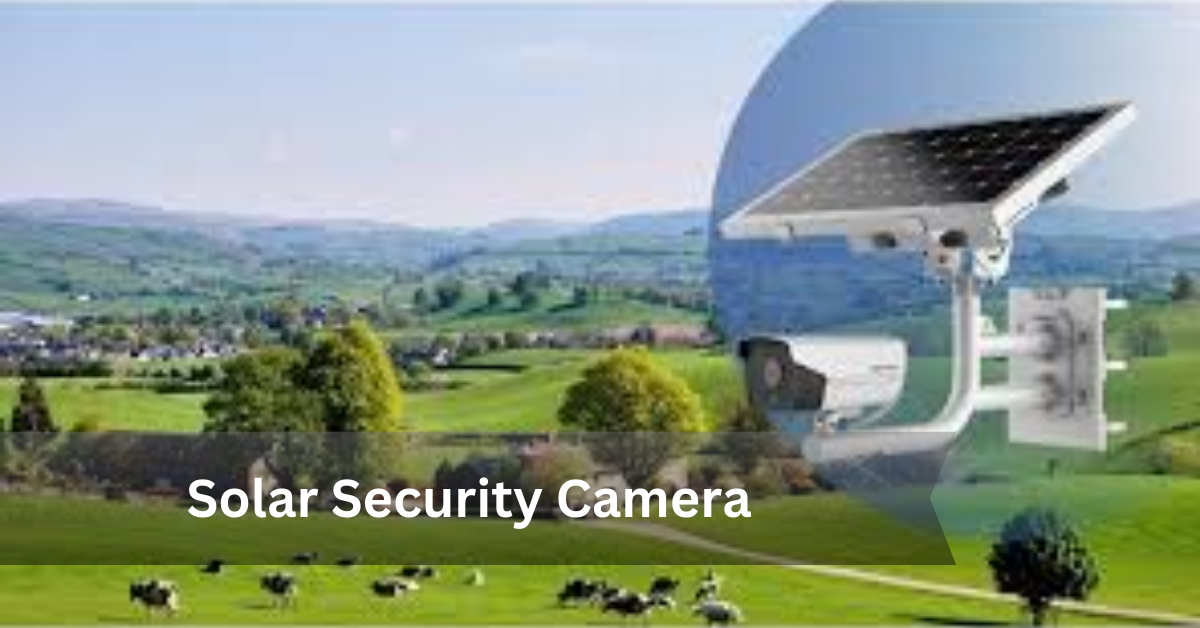Tired of charging batteries or dealing with messy wiring?
Solar security cameras are changing the game—offering a clean, efficient, and completely wireless way to keep an eye on your property.
As solar-powered technology continues to advance in 2025, more homeowners, businesses, and off-grid property owners are turning to solar security solutions for peace of mind.
Solar security cameras are better for the environment and cost-effective, low-maintenance, and ideal for both remote and urban installations. With features like motion detection, night vision, and app-based monitoring, you no longer have to choose between convenience and reliability.
In this guide, we’ll walk you through the top solar security camera models of 2025.
Let’s dive in.
How Do Solar Security Cameras Work?
Solar security cameras operate without traditional power sources by combining energy-efficient hardware with renewable energy systems. Here’s a breakdown of their core components and functionality:
Built-in Battery + Solar Panel System
At the heart of every solar security camera is a rechargeable lithium battery, which is continuously charged by the solar panel.
- During the day, the solar panel absorbs sunlight and converts it into electrical energy.
- That energy charges the battery, which then powers the camera 24/7—even during cloudy days or overnight.
Many systems are designed to last several days on a full charge, even without sun exposure, making them reliable in most climates.
Day/Night Cycle Functionality
Solar-powered cameras are built for round-the-clock surveillance.
- Daytime: The camera uses the solar panel to charge the battery while recording in full color.
- Nighttime: Infrared (IR) night vision or spotlight LEDs kick in, drawing from the battery for continuous recording or motion-triggered events.
Some advanced models even offer AI-powered motion detection to reduce false alerts and optimize battery usage.
Cloud vs Local Storage Options
Solar security cameras typically store footage in one of two ways:
- Cloud Storage: Footage is uploaded to a secure server (usually requires Wi-Fi and/or a monthly subscription).
- Local Storage: Uses microSD cards, NVRs (Network Video Recorders), or even USB drives to store footage directly in the device—ideal for those who want a WiFi-free or low-data setup.
Some models offer hybrid options, letting users choose between the cloud, local storage, or both for backup.
Key Features to Look For
When choosing a solar security camera, understanding which features truly matter can help you pick a model that balances performance, price, and long-term value. Below are the essentials to consider:
Motion Detection
Look for cameras with smart motion detection to reduce false alarms from leaves, pets, or passing cars.
- PIR (Passive Infrared) Sensors are best for accurate heat-based motion detection.
- Some advanced models use AI-based object recognition to distinguish between humans, animals, and vehicles.
Night Vision & IR Range
Night vision is critical for 24/7 security.
- Most models use infrared (IR) LEDs to provide black-and-white visibility in total darkness.
- For better visibility, look for spotlight-equipped cameras or color night vision.
- IR Range of 30–65 feet is standard for residential use; longer ranges may be ideal for farms or remote sites.
Video Quality (1080p / 2K / 4K)
Resolution affects clarity—especially for identifying faces or license plates.
- 1080p (Full HD): Great for standard home use.
- 2K (QHD): Ideal for enhanced detail in larger areas.
- 4K (Ultra HD): Best for professional or commercial-grade surveillance.
Make sure your storage option (SD card or cloud) supports the selected resolution to avoid frame drop or compression.
Mobile App Integration
Real-time access to your camera feed is a must.
- Choose cameras with iOS and Android support.
- Key features include push alerts, live streaming, footage playback, and 2-way audio.
- Check app reviews for ease of use and update reliability.
Weatherproof Ratings (IP65/IP66)
Outdoor cameras need to withstand the elements.
- IP65: Resistant to water jets and dust—suitable for sheltered outdoor areas.
- IP66: Fully weatherproof—great for full exposure (rain, dust, wind).
- For harsher environments (coastal or snowy regions), prioritize high-quality housing and seals.
Top-Rated Solar Security Cameras (2025 Picks)
Here are the best solar-powered security cameras of 2025—handpicked based on performance, features, reviews, and overall value:
1. Reolink Argus 3 Pro with Solar Panel
Best for: All-in-one home security

- Resolution: 2K QHD
- Night Vision: IR + Color Night Vision
- Power: Solar panel + internal battery
- Connectivity: 2.4GHz WiFi
- Storage: microSD (up to 128GB) + Reolink Cloud
- App Integration: Reolink app (iOS & Android)
- Weatherproof: IP65
- Two-Way Audio: Yes
- Smart Detection: Person/vehicle detection
Pros:
✔️ Excellent video quality
✔️ Smart alerts & AI detection
✔️ No base station required
Cons:
❌ No 5GHz WiFi support
❌ Requires separate solar panel purchase (or bundled option)
2. Arlo Essential XL Spotlight (Solar Kit)
Best for: Smart home users (Arlo ecosystem)

- Resolution: 1080p Full HD
- Night Vision: IR + integrated spotlight
- Power: Solar charging + extended battery life
- Connectivity: WiFi
- Storage: Arlo Cloud (subscription) + local with hub
- App Integration: Arlo Secure App
- Weatherproof: IP65
- Smart Features: AI detection (people, animals, vehicles)
Pros:
✔️ Long battery life
✔️ Compatible with Alexa & Google
✔️ Smart object detection
Cons:
❌ Requires cloud subscription for full features
❌ No microSD slot
3. Eufy SoloCam S220 (S40)
Best for: Subscription-free users
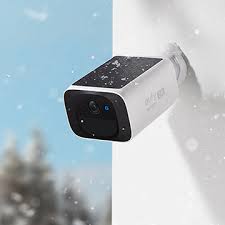
- Resolution: 2K QHD
- Night Vision: IR + Color Spotlight
- Power: Integrated solar panel + battery
- Connectivity: WiFi
- Storage: 8GB internal (no cloud needed)
- App Integration: Eufy Security App
- Weatherproof: IP67
- Smart Alerts: Human detection
Pros:
✔️ No monthly fees
✔️ Built-in storage
✔️ Excellent solar performance
Cons:
❌ No expandable storage
❌ Not ideal for large properties
4. Defender Guard Pro 2K Solar
Best for: DIY-friendly full coverage

- Resolution: 2K QHD
- Night Vision: IR Night Vision
- Power: Solar panel + rechargeable battery
- Connectivity: WiFi
- Storage: MicroSD (up to 256GB)
- App Integration: Defender Guard App
- Weatherproof: IP67
Pros:
✔️ Easy to install
✔️ Sharp 2K video
✔️ Budget-friendly
Cons:
❌ Limited third-party smart home support
❌ No color night vision
5. Soliom S600 4G LTE Solar Security Camera
Best for: Remote/rural locations
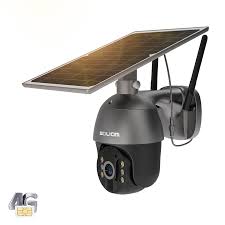
- Resolution: 1080p Full HD
- Night Vision: IR up to 65 ft
- Power: Solar + large battery
- Connectivity: 4G LTE (SIM required)
- Storage: microSD (up to 128GB) + Cloud
- App Integration: Soliom+ App
- Pan/Tilt: 320° pan / 90° tilt
- Weatherproof: IP66
Pros:
✔️ Cellular—no WiFi required
✔️ Full coverage with pan/tilt
✔️ Great for off-grid sites
Cons:
❌ Monthly data plan needed
❌ Setup can be tricky for beginners
6. ieGeek ZS-GX3S Solar Camera
Best for: Budget-conscious users
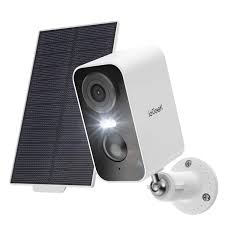
- Resolution: 2K
- Night Vision: IR LEDs
- Power: Separate solar panel
- Connectivity: WiFi
- Storage: microSD (up to 128GB) + Cloud
- App Integration: CloudEdge App
- Two-Way Audio: Yes
- Weatherproof: IP65
Pros:
✔️ Affordable and reliable
✔️ Easy setup
✔️ Good battery life
Cons:
❌ App UI not as polished
❌ No AI detection
7. Ring Stick Up Cam Solar (2nd Gen)
Best for: Existing Ring & Alexa users
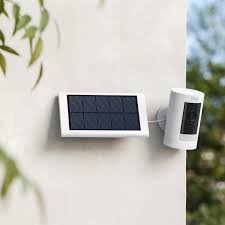
- Resolution: 1080p Full HD
- Night Vision: Standard IR
- Power: Solar panel + battery
- Connectivity: WiFi
- Storage: Ring Cloud (subscription required)
- App Integration: Ring App + Alexa
- Weatherproof: IPX5
Pros:
✔️ Seamless Alexa integration
✔️ Reliable performance
✔️ Easy-to-use app
Cons:
❌ Requires subscription for video history
❌ No local storage option
Solar Security Camera Comparison Table (2025)
| Camera Model | Price Range (USD) | Resolution | Connectivity | Storage Type |
| Reolink Argus 3 Pro | $100 – $130 | 2K QHD | WiFi (2.4GHz) | microSD + Cloud |
| Arlo Essential XL + Solar | $120 – $150 | 1080p HD | WiFi | Cloud (local w/ hub) |
| Eufy SoloCam S220 (S40) | $140 – $170 | 2K QHD | WiFi | Built-in (8GB) |
| Defender Guard Pro 2K | $90 – $120 | 2K QHD | WiFi | microSD (256GB max) |
| Soliom S600 (4G LTE) | $170 – $220 | 1080p HD | Cellular (4G LTE) | microSD + Cloud |
| ieGeek ZS-GX3S | $70 – $90 | 2K QHD | WiFi | microSD + Cloud |
| Ring Stick Up Cam Solar | $120 – $150 | 1080p HD | WiFi | Cloud only (subscription) |
Notes:
- Prices are estimated ranges as of 2025 and may vary by region and retailer.
- Cellular models (like Soliom S600) require a SIM card and mobile data plan.
- Ring and Arlo require subscriptions for full features like video history.
Pros & Cons of Solar Security Cameras
| Pros | Cons |
| Eco-friendly & sustainable | May not work well in low sunlight areas |
| No wiring or power costs | May require occasional manual adjustments |
| Ideal for off-grid or rural use | Initial setup cost can be higher |
Things to Know Before Buying a Solar Security Camera
Solar-powered security cameras offer excellent flexibility and sustainability, but they’re not without trade-offs. Understanding these limitations helps users make better decisions and sets realistic expectations.
Disadvantages of Solar Security Cameras
1. Dependence on Sunlight
- Solar cameras need consistent sunlight to stay charged.
- Cloudy or rainy environments can reduce charging efficiency.
- Less ideal for forested areas, shaded locations, or high-latitude zones.
2. Potentially Lower Video Quality
- Budget models may lack full HD (1080p or higher).
- May offer only event-based recording (no 24/7 capture).
- Some lack advanced features like color night vision or wide-angle view.
3. Higher Upfront Costs
- Solar cameras typically cost more due to solar panels and high-capacity batteries.
- May not be cost-effective for short-term use or temporary installations.
4. Maintenance Requirements
- Solar panels must be kept clean for optimal charging.
- Batteries may require replacement every 3–5 years.
- Extreme weather conditions can impact performance.
5. Wi-Fi & Connectivity Limitations
- Most solar models use Wi-Fi for app control and storage.
- Connectivity issues may arise in remote areas or with weak signals.
- Some models offer 4G LTE but require a SIM and data plan.
6. Scalability and Flexibility
- Harder to expand for large properties (vs. wired NVR systems).
- Installation is limited to areas with sufficient sun exposure.
Lifespan of Solar Security Cameras
How long do they really last?
| Component | Average Lifespan |
| Solar Panel | 20 – 25 years |
| Battery | 3 – 7 years (replaceable) |
| Camera Unit | 5 – 10 years |
📌 Pro Tip: Regular cleaning and battery replacement can significantly extend performance and reliability.
Are Solar Security Cameras Waterproof?
Yes—most quality models come with IP65 or IP66 waterproof ratings, making them safe for year-round outdoor use in rain, wind, and snow.
- IP65: Dust-tight, protected against water jets.
- IP66: Dust-tight, with higher water protection (stronger rain and wash-downs).
Always confirm the rating in the product specs before purchase.
Best Brands for Solar-Powered Security Cameras (2025)
Here are the top-rated and trusted brands based on performance, ease of use, and durability:
| Brand | Best For |
| Lorex | High-performance cameras with solar add-ons |
| Ring | Smart home integration, reliable ecosystem |
| Google Nest | Seamless integration with Google Home |
| Arlo | DIY-friendly setups with premium features |
| SimpliSafe | Simple setup, good for first-time users |
| Eufy | Local storage with no monthly fees |
| Reolink | Best overall mix of price, quality, and features |
Tips for Installing Solar Security Cameras
Proper installation is crucial to ensure your solar-powered security camera works efficiently year-round. Follow these best practices to optimize performance and reliability.
1. Choose the Sunniest Mounting Location
- Install the camera in a location that receives direct sunlight for at least 4 to 6 hours per day.
- Avoid shaded areas such as under trees, awnings, or roof overhangs.
- For best results, angle the solar panel toward the sun’s path—typically south-facing in the northern hemisphere.
2. Keep the Solar Panel Clean
- Regularly clean the solar panel to remove dust, debris, and bird droppings that can block sunlight.
- Use a soft cloth and water to gently wipe the panel; avoid abrasive cleaners that could damage it.
- Clean the panel monthly or more often in dusty or rainy environments.
3. Use Both microSD and Cloud Storage
- Local storage (microSD) provides a backup if cloud access or internet fails.
- Cloud storage offers remote access and an extra layer of data protection.
- Enable auto-overwrite on the SD card to avoid running out of space.
Additional Tips:
- Test Wi-Fi signal strength at the installation point before mounting.
- Use adjustable mounts to fine-tune solar exposure throughout the year.
- Install the camera at a height of 8 to 10 feet for a wide field of view and added tamper resistance.
Use Cases & Testimonials of Solar Security Cameras
Solar-powered security cameras are becoming a go-to choice for users who need reliable, off-grid surveillance solutions. From wide-open farmland to mobile homes and job sites, here’s how they’re making a difference:
Farm Monitoring
Solar cameras are ideal for large, remote agricultural properties where running wires or installing traditional power infrastructure is impractical.
Key Benefits:
- Monitor livestock, equipment, and perimeters remotely.
- No need for consistent power or Wi-Fi infrastructure.
- Motion alerts help deter intruders and predators.
Testimonial:
“I installed a Reolink solar cam on the barn, and it’s been flawless. Zero wiring, and I get alerts right to my phone—even during storms.”
— Mike H., Small Farm Owner in Texas
Construction Site Surveillance
Construction zones are often temporary and lack power sources. Solar security cameras provide 24/7 monitoring without the need for complex installation.
Key Benefits:
- Protect tools and equipment from theft or vandalism.
- Capture project progress with time-lapse and live feeds.
- Easily relocate the camera as the project evolves.
Expert Insight:
“For job sites, I always recommend solar units with cellular backup. They’re rugged, easy to set up, and don’t need a technician to relocate.”
— BuildWise Reviews, YouTube Channel
RV / Vanlife Setup
Vanlifers and RV travelers benefit from compact, solar-powered cameras that provide peace of mind while parked at campsites or in remote locations.
Key Benefits:
- Mobile security that moves with you.
- Ideal for boondocking or off-grid camping.
- Often integrates with mobile apps for real-time viewing.
User Quote:
“I’ve got one watching my RV while I hike. It even caught someone snooping last month. Totally worth it.”
— Sarah T., Full-Time Vanlifer
Queries related to the Solar Security Camera
Best Solar-Powered Camera for 24/7 Recording
Look for cameras like Reolink Argus 3 Pro, offering continuous recording and HomeKit compatibility via Homebridge/Scrypted setup.
Best Outdoor Solar Camera System
The Ring Stick Up Cam Solar provides a robust outdoor solution, with solar power and smart features like motion detection.
Best Solar Security Camera
The Arlo Pro 4 Solar Camera delivers excellent video quality, easy integration, and a flexible solar setup for continuous monitoring.
Best Outdoor Wireless Security Camera System Solar Powered
Consider the Lorex Solar Wireless Security Camera System for full wireless, solar-powered coverage with excellent video and motion detection.
Solar Security Camera with Wi-Fi
The Blink Outdoor Solar Camera provides a seamless Wi-Fi connection with solar power, ensuring non-stop outdoor security.
Solar Security Camera Outdoor
The Reolink Go Plus offers outstanding outdoor security with 4G LTE connectivity and solar power, perfect for remote locations.
Solar Security Camera with No Subscription
The Eufy Security SoloCam offers solar-powered security without monthly fees, perfect for budget-conscious users.
Solar Security Camera 360
The Amcrest 360° Solar PTZ Camera delivers full rotation, night vision, and high-definition video with solar power for optimal security.
Solar Security Camera 5G
For high-speed connectivity, the Reolink Go PT offers 5G mobile network support combined with solar power for 24/7 remote monitoring.
Solar Security Camera with App
The Arlo Pro 3 Solar Camera integrates easily with the Arlo app, allowing you to control and view footage directly from your smartphone.
FAQ’s
Do solar security cameras work at night?
A: Yes, most models have built-in batteries and infrared night vision to work after dark.
How long do solar-powered security cameras last?
A: The average lifespan is 3–5 years, depending on usage and weather exposure.
Can solar security cameras work without Wi-Fi?
A: Yes, some models use 4G LTE or SD card storage to function offline.
What happens on cloudy or rainy days?
A: Cameras store power in backup batteries and can usually operate for several days without direct sunlight.
Conclusion
Solar security cameras are ideal for off-grid setups, eco-conscious users, and those wanting low-maintenance protection. With powerful batteries, HD video, and motion alerts, they’re a smart investment for 2025 and beyond.
Browse our expert picks for solar security cameras and upgrade your home or property with sun-powered peace of mind.

